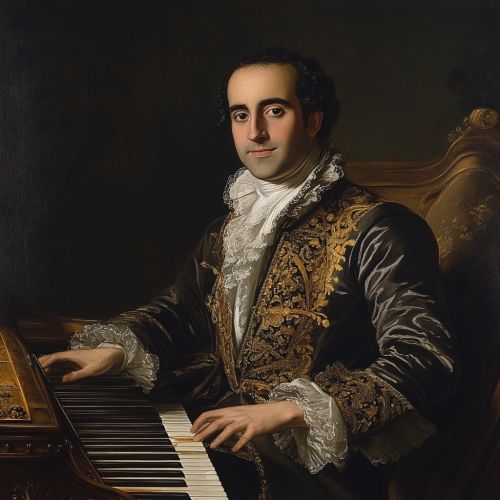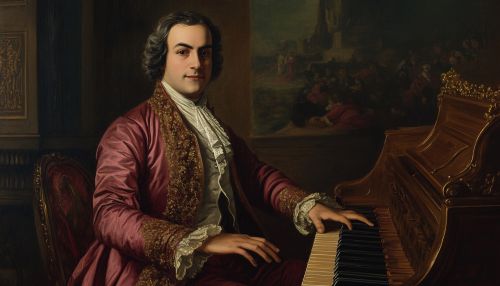Alessandro Scarlatti: Difference between revisions
No edit summary |
No edit summary |
||
| Line 8: | Line 8: | ||
In 1684, Scarlatti moved to Naples, where he became the maestro di cappella to the Spanish viceroy. This position allowed him to exert significant influence on the musical life of the city. During his tenure in Naples, Scarlatti composed numerous operas, including "La Rosaura" and "Pirro e Demetrio." His operatic style evolved to include more elaborate arias and recitatives, which became characteristic of the [[Neapolitan opera]]. | In 1684, Scarlatti moved to Naples, where he became the maestro di cappella to the Spanish viceroy. This position allowed him to exert significant influence on the musical life of the city. During his tenure in Naples, Scarlatti composed numerous operas, including "La Rosaura" and "Pirro e Demetrio." His operatic style evolved to include more elaborate arias and recitatives, which became characteristic of the [[Neapolitan opera]]. | ||
[[Image:Detail-98243.jpg|thumb|center|Portrait of Alessandro Scarlatti in Baroque attire, seated at a harpsichord.]] | [[Image:Detail-98243.jpg|thumb|center|Portrait of Alessandro Scarlatti in Baroque attire, seated at a harpsichord.|class=only_on_mobile]] | ||
[[Image:Detail-98244.jpg|thumb|center|Portrait of Alessandro Scarlatti in Baroque attire, seated at a harpsichord.|class=only_on_desktop]] | |||
== Contributions to Opera == | == Contributions to Opera == | ||
Latest revision as of 20:39, 8 October 2024
Early Life and Education
Alessandro Scarlatti, born on May 2, 1660, in Palermo, Sicily, was a prolific Italian Baroque composer. He is widely recognized for his contributions to the development of opera and the Neapolitan School of music. Scarlatti's early musical education is not well-documented, but it is known that he moved to Rome in his youth, where he likely received training from established composers of the time, such as Giacomo Carissimi.
Career in Rome
Scarlatti's career began to flourish in Rome, where he composed his first opera, "Gli equivoci nel sembiante," in 1679. This work marked the beginning of his long and influential career in opera composition. During his time in Rome, Scarlatti was associated with several prominent patrons, including Queen Christina of Sweden and Cardinal Ottoboni. His works from this period include a variety of operas, oratorios, and cantatas, which showcased his mastery of vocal and instrumental writing.
Neapolitan Period
In 1684, Scarlatti moved to Naples, where he became the maestro di cappella to the Spanish viceroy. This position allowed him to exert significant influence on the musical life of the city. During his tenure in Naples, Scarlatti composed numerous operas, including "La Rosaura" and "Pirro e Demetrio." His operatic style evolved to include more elaborate arias and recitatives, which became characteristic of the Neapolitan opera.


Contributions to Opera
Scarlatti is often credited with pioneering the da capo aria, a form that became a staple of Baroque opera. This structure, consisting of an A-B-A format, allowed singers to showcase their virtuosity through elaborate ornamentation during the repeat of the A section. Scarlatti's operas also featured more complex orchestration and dramatic expression, setting a new standard for the genre.
Sacred Music
In addition to his operatic works, Scarlatti composed a significant body of sacred music. His oratorios, such as "La Giuditta" and "Il primo omicidio," are notable for their dramatic intensity and intricate counterpoint. Scarlatti also wrote numerous masses, motets, and other liturgical pieces, which were performed in churches throughout Italy.
Instrumental Works
Scarlatti's instrumental compositions, though less well-known than his vocal works, are equally important. He wrote a series of keyboard toccatas, sonatas, and concertos that display his innovative approach to harmony and form. His keyboard music, in particular, influenced later composers, including his own son, Domenico Scarlatti.
Legacy and Influence
Alessandro Scarlatti's influence on the development of Baroque music cannot be overstated. His innovations in opera, sacred music, and instrumental composition set the stage for future generations of composers. Scarlatti's students included notable figures such as Francesco Durante and Giovanni Battista Pergolesi, who continued to develop the Neapolitan style.
Personal Life
Scarlatti married Antonia Anzalone in 1678, and the couple had ten children, several of whom became musicians. His most famous son, Domenico Scarlatti, achieved renown as a composer of keyboard music. Despite his professional success, Alessandro Scarlatti faced financial difficulties later in life and struggled to secure stable patronage.
Death and Posthumous Recognition
Alessandro Scarlatti died on October 22, 1725, in Naples. His music fell into relative obscurity after his death but was revived in the 20th century through the efforts of musicologists and performers. Today, Scarlatti is celebrated as a key figure in the history of Baroque music, and his works continue to be performed and recorded.
